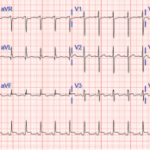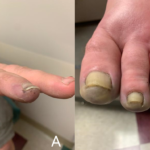Discussion
This case report illustrates the musculoskeletal anomalies seen in fetal hydantoin syndrome. Hypoplastic distal phalanges and fingernails are common features. In this case, the patient did not represent the full picture of the syndrome.
The full syndrome can include hypoplastic distal phalanges with small fingernails, a digital-type thumb, abnormal palmar creases, increased frequency of low arch, digital dermal ridge patterns and hip dislocation. Our patient had only hypoplastic distal phalanges, small fingernails and a thinner-than-normal thumb, described as a digital-type thumb.



